User:Hansonrstolaf/Sandbox/Holton

The Holton Taxol total synthesis, published by Robert A. Holton and his group at Florida State University in 1994 was the first total synthesis of Taxol (generic name: paclitaxel) [1] [2] [3].
The Holton Taxol total synthesis is a good example of a linear synthesis starting from commercially available natural compound patchoulene oxide. This epoxide can be obtained in two steps from the terpene patchoulol and also from borneol. The reaction sequence is also enantioselective, synthesizing (+)-Taxol from (-)-patchoulene oxide or (-)-Taxol from (-)-borneol with a reported specific rotation of +- 47° (c=0.19 / MeOH). The Holton sequence to Taxol is relatively short compared to that of the other groups with an estimated 37 step not counting the addition of the amide tail. One of the reasons is that the patchoulol starting compound already contains 15 of the 20 carbon atoms required for the Taxol ABCD ring framework.
Other raw materials besides the already mentioned patchoulene oxide required for this synthesis are 4-pentenal, m-chloroperoxybenzoic acid, methyl magnesium bromide and phosgene. Two key chemical transformations in this sequence are a Chan rearrangement and a sulfonyloxaziridine enolate oxidation.
Retrosynthesis[edit]
 |
| Retrosynthesis 500 |
|---|
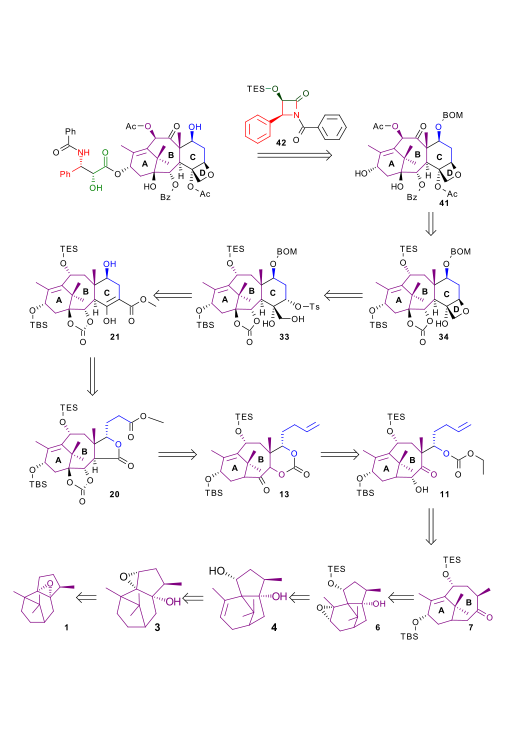 |
| Retrosynthesis 520 |
|---|
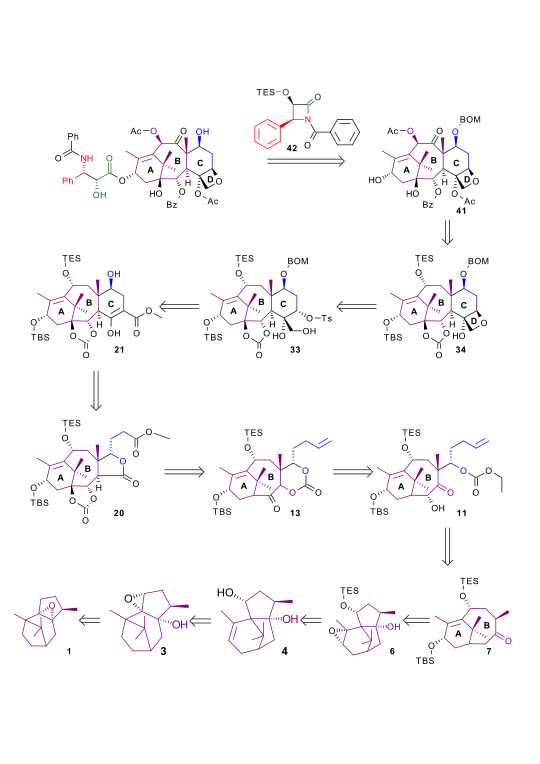 |
| Retrosynthesis 540 |
|---|
 |
| Retrosynthesis 560 |
|---|
 |
| Retrosynthesis 580 |
|---|
 |
| Retrosynthesis 600 |
|---|
 |
| Retrosynthesis 700 |
|---|
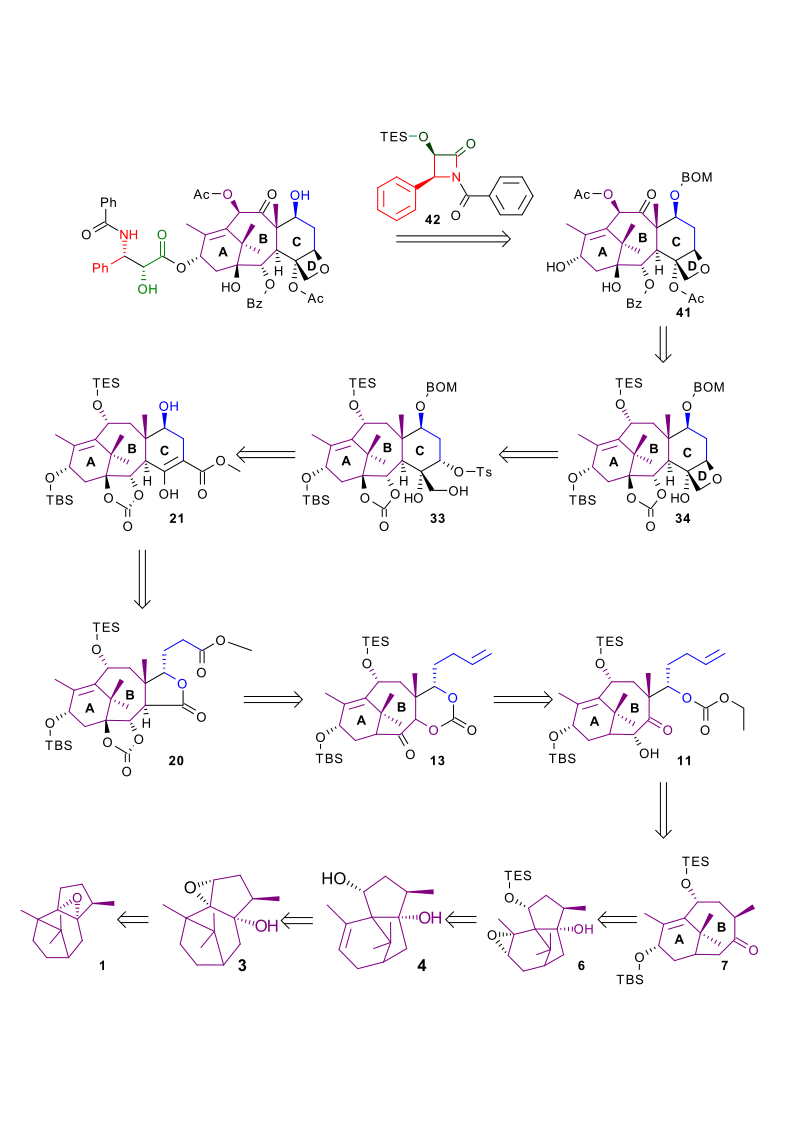 |
| Retrosynthesis 800 |
|---|
AB Ring synthesis[edit]
Starting from patchoulene oxide 1 in Scheme 1 the first part is the creation of the fused 6 and 8 membered AB ring system through a sequence of rearrangement reactions. Reaction of 1 with tert-butyllithium removes the acidic α-epoxide proton leading to an elimination reaction and ring-opening of the epoxide to the allyl alcohol 2. The resultant alkene group is oxidized to an epoxide group in 3 with tert-butylperoxide and tin tetraisopropoxide. In the subsequent reaction the lewis acid boron trifluoride catalyses the ring opening of the epoxide followed by a skeletal rearrangement of the isopropyl bridge and a second elimination reaction to the diol 4. The newly created hydroxyl group is protected as the TES silyl ether 5 by reaction with triethylsilylchloride, DMAP and pyridine. The also newly created alkene group is epoxidized by reaction with m-CPBA. The epoxide 6 is unstable and an epoxy alcohol Grob fragmentation reaction follows whereby driven by the oxidation of the alcohol group to a ketone group a carbon-carbon bond gives way to the desired AB ring in 7. The hydroxyde group is protected as the TBS silyl ether. In the next phase the required carbon atoms are added for the formation of the C ring through the available ketone group. The ketone group in 7 is converted into the magnesium bromide enolate 8 by action of LDA and methyl magnesium bromide to which is added 4-pentenal in an aldol reaction to the secondary alcohol 9. This group is protected as the asymmetric carbonate ester 10 by reaction first with phosgene, pyridine in dichloromethane and then with ethanol. The introduction of the acyloin group in 11 is with stereochemical control, enolate formation by action of LDA is followed by its oxidation with (+)-camphorsulfonyl oxaziridine for the enantiomer leading to Taxol. Reduction of the ketone group with Red-Al to an alcohol with basic workup is accompanied with a carbonate rearrangement to the new cyclic carbonate ester 12 with elimination of ethanol.
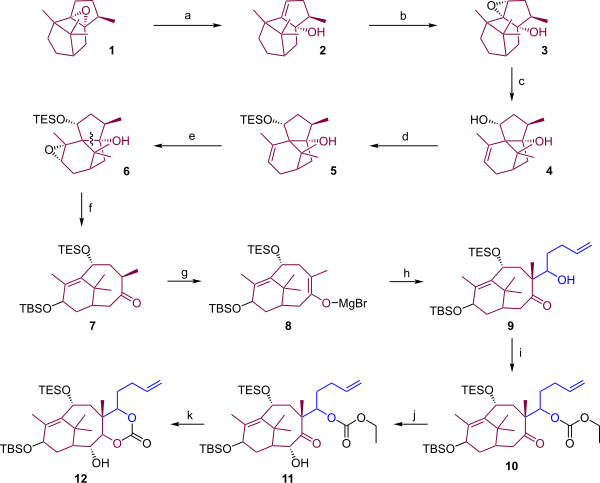 |
| Scheme 1 |
|---|
C Ring preparation[edit]
As shown in Scheme 2, Swern oxidation of alcohol 12 gave ketone 13. The carbonyl group was used to set the functionality of the B ring in preparation for formation of the C ring. The first step in this sequence was a Chan rearrangement of the carbonate ester using lithium tetramethylpiperidide, which gave α-hydroxyester 14. The hydroxyl group was reductively removed using samarium(II) iodide to give stable enol 15. Chromatography of this enol on silica gel gave the cis diastereomer 16 predominantly, along with a small amount of the trans isomer, which could be recycled. Treatment of this ketone with lithium tetramethylpiperidide and (+)-camphorsulfonyl oxaziridine gave α-hydroxyketone 17. Reduction of the ketone using Red-Al also resulted in epimerization to give the required trans-fused lactone 18.
|
|
| Scheme 2 |
|---|
C Ring synthesis[edit]
In Scheme 3, diol 18 is protected with phosgene as a carbonate ester (19).
The terminal alkene group was converted to a methyl ester using ozonolysis, followed by oxidation with potassium permanganate and esterification with diazomethane.
The second C-C bond formation step in the cyclohexane C ring synthesis was a Dieckman condensation of 20 using lithium diisopropylamide as a base at -78°C to give enol ester 21.
Decarboxylation of 21 required protection of the hydroxyl group as the 2-methylpropyl ether (22).
With the protecting group in place decarboxylation is effected with potassium thiophenolate in dimethylformamide to give protected hydroxy ketone 23.
In the next two steps the MOP protecting group was removed by acid and alcohol 24 was reprotected with another more robust ether protecting group benzyloxymethyl (25).
The ketone was converted into trimethylsilyl enol ether 26, which was subsequently oxidized in a Rubottom oxidation using m-chloroperbenzoic acid to give TMS protected acyloin 27.
At this stage the final missing carbon atom in the Taxol ring framework was introduced in a Grignard reaction of ketone 28 with a 10-fold excess of methylmagnesium bromide to give tertiary alcohol 28.
The Burgess reagent brought about an elimination reaction of the alcohol to an exocyclic alkene and acidic workup provided the free allyl alcohol 29.
| Scheme 3 |
|---|
TEST:
| test of export to svg |
|---|
D Ring synthesis and AB ring elaboration[edit]
In this section of the Holton Taxol synthesis the oxetane D ring is completed and ring B is functionalized with the correct substituents. The allyl alcohol 29 in Scheme 4 is oxidized with osmium tetroxide in pyridine to the triol 30. The three alcohol groups are modified in the next 5 reaction steps. The primary alcohol is protected by reaction with trimethylsilylchloride as the TSM ether 31 and this makes it possible to turn the secondary alcohol into a tosylate leaving group in 32 by reaction with tosyl chloride. The TMS group no longer needed is removed in 33 with acetic acid. The next step is the actual oxetane formation (34) by nucleophilic displacement with inversion of the tosyl group on C5 by the hydroxyl nucleophile on C20. The remaining tertiary alcohol is acylated with acetic anhydride, DMAP and pyridine (35) and then the C10 hydroxyl group is reintroduced in 36 by cleavage of the TES silyl ether with hydrogen fluoride pyridine complex in acetonitrile. The carbonate ester is cleaved by reaction with phenyllithium in THF at -78°C to the hydroxy benzoate 37 completing the lower part of the B ring. In the upper part of the same ring the hydroxyl group is oxidized to a ketone in 38 with a TPAP / NMO system, turned into the enolate with potassium tert-butoxide in THF at low temperatures and further oxidized by reaction with a suspension of benzeneseleninic anhydride to the acyloin 39 which is subsequently acylated to the acylketone 40.
 |
| Scheme 4 |
|---|
Tail addition[edit]
The tail addition step in this synthesis (scheme 5) was identical to that in the Nicolaou tail addition and based on the Ojima lactam. The C13 hydroxyl group in 40 was deprotected by silyl ether cleavage with the TASF reagent. Reaction of the lithium alkoxide of 41 with the Ojima lactam 42 gave the tail in 43. A silyl deprotection step at the TES position (44) and a BOM deprotection step with hydrogen and palladium on carbon gave (-)-Taxol 45.
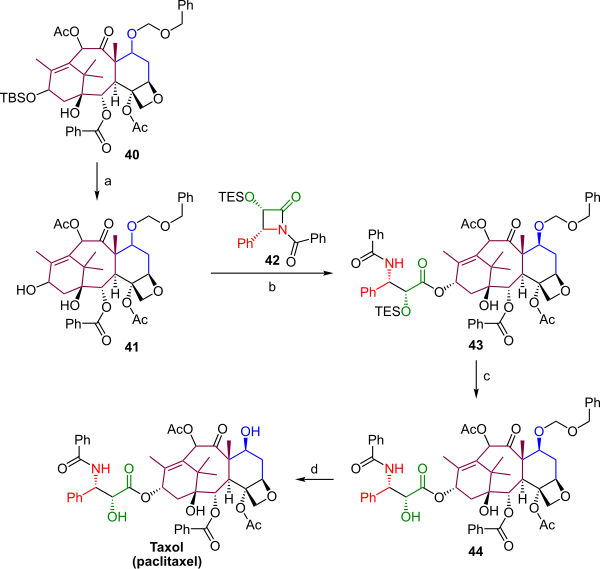 |
| Scheme 5 |
|---|
Precursor synthesis[edit]
The synthesis of patchoulene oxide starts from patchoulol. Patchoulol (45) is a tricyclic compound which gives a carbocationic rearrangement reaction followed by an elimination reaction in presence of a protic acid. The driving force for the rearrangement is relief of ring strain. Zaitsev's rule applies in the elimination. In the second step the newly formed double bond in 46 is epoxidized to patchoulene oxide 1.

See also[edit]
- Paclitaxel total synthesis
- Danishefsky Taxol total synthesis
- Kuwajima Taxol total synthesis
- Mukaiyama Taxol total synthesis
- Nicolaou Taxol total synthesis
- Wender Taxol total synthesis
References[edit]
- ^ First total synthesis of taxol 1. Functionalization of the B ring Robert A. Holton, Carmen Somoza, Hyeong Baik Kim, Feng Liang, Ronald J. Biediger, P. Douglas Boatman, Mitsuru Shindo, Chase C. Smith, Soekchan Kim, et al.; J. Am. Chem. Soc.; 1994; 116(4); 1597-1598. DOI Abstract
- ^ First total synthesis of taxol. 2. Completion of the C and D rings Robert A. Holton, Hyeong Baik Kim, Carmen Somoza, Feng Liang, Ronald J. Biediger, P. Douglas Boatman, Mitsuru Shindo, Chase C. Smith, Soekchan Kim, and et al. J. Am. Chem. Soc.; 1994; 116(4) pp 1599 - 1600 DOI Abstract
- ^ A synthesis of taxusin Robert A. Holton, R. R. Juo, Hyeong B. Kim, Andrew D. Williams, Shinya Harusawa, Richard E. Lowenthal, Sadamu Yogai J. Am. Chem. Soc.; 1988; 110(19); 6558-6560. Abstract
